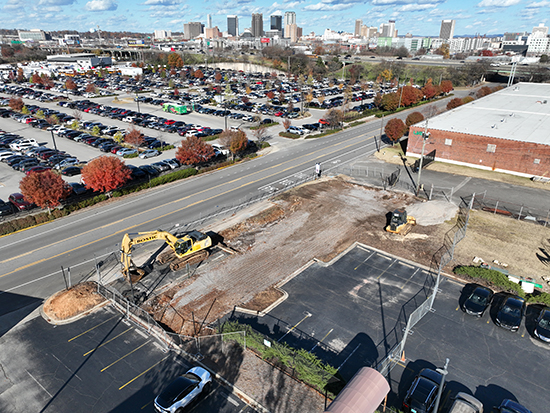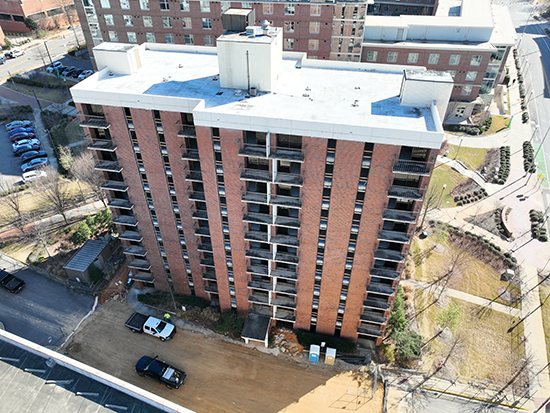 Demolition work at the 825 Building in December 2024. Image courtesy UAB FacilitiesAs UAB continues to embrace its Campus Master Plan, new buildings are arising all over the university — including new homes for genomic and interdisciplinary biomedical research, the School of Engineering and inpatient rehabilitation services.
Demolition work at the 825 Building in December 2024. Image courtesy UAB FacilitiesAs UAB continues to embrace its Campus Master Plan, new buildings are arising all over the university — including new homes for genomic and interdisciplinary biomedical research, the School of Engineering and inpatient rehabilitation services.
Likewise, as UAB inventories existing buildings, it often razes aging and energy-inefficient structures, such as the 825 Building, the Humanities Building and, most recently, Denman Hall, the demolition of which began in January.
Razing a building can take many forms, such as the traditional method of breaking it apart using a long-arm machine or imploding it, and a building’s location is an important part of that decision.
Curious about the process and what it might mean for you? Here’s what to expect:
1. Safety is first.
Each building slated for demolition undergoes a rigorous inspection in order to ensure the work is done safely for people and the environment. The timeframe for this process varies by building.
2. Some power outages are normal.
To ensure safety, certain projects require electrical service to be shut off for the building being demolished and also for those nearby. The Facilities Division partners with local utilities to ensure the outages are scheduled as conveniently as possible and that those affected are notified in advance.
3. Things can get shaky.
UAB monitors that. During the demolition process, the site’s vibration levels are regularly monitored to ensure they stay in a safe range for the area and nearby buildings.
 Following abatement, active demolition at Denman Hall began in late January 2025, and is ongoing now. Image courtesy UAB Facilities4. It can get dusty.
Following abatement, active demolition at Denman Hall began in late January 2025, and is ongoing now. Image courtesy UAB Facilities4. It can get dusty.
Air quality is closely monitored during demolition UAB takes many precautions to limit the impact of dust. Standard air-monitoring systems are used to measure air quality and ensure it remains in safe ranges determined by the U.S. Environmental Protection Agency. Many demolitions are “wet,” meaning building remnants are regularly sprayed down with water to limit dust carried by wind.
5. Expect some impact on traffic flow — by car or on foot.
Sidewalks and streets often need to be closed for a portion of the project to keep pedestrians safe. Facilities project managers will work with contractors and city representatives to limit closings to non-peak hours when possible. Closures are always marked and notices of traffic impacts are communicated through UAB emails, websites and social media. You can also check the UAB Construction Map for detailed, up-to-date closure information.
6. What can be reused or recycled is.
Through its Construction and Demolition Waste Management Plan, UAB encourages contractors to find opportunities to recycle and reuse materials to divert waste from Alabama’s landfills; this is standard for university projects.